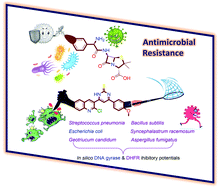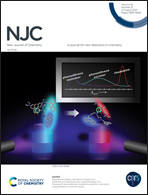The antimicrobial potential and pharmacokinetic profiles of novel quinoline-based scaffolds: synthesis and in silico mechanistic studies as dual DNA gyrase and DHFR inhibitors†
Abstract
The resistance of pathogenic microbes to currently available antimicrobial agents has been considered a global alarming concern. Hence, close attention should be paid to the development of novel potent antimicrobials. Herein, we report the synthesis, in vitro antimicrobial evaluation, of two novel sets of quinoline derivatives as potential DNA gyrase and DHFR inhibitors. The design of new compounds depended on modifying the structural aspects of previously reported fluoroquinolones. In both sets, the methyl group replaced the fluorine atom at C-6. In the first set, the diverse heterocyclic fragments of reported antimicrobial potentials, including pyrazole, isoxazole, and pyrimidine, were attached to C-3 of the quinoline scaffold. In the second set, the quinolone ring was replaced with the pyrazolo[3,4-b]quinoline scaffold to examine the effect of this action on the antimicrobial activity and the in silico virtual binding with DNA gyrase and DHFR. The preliminary antimicrobial activity of new compounds was assessed against a panel of pathogenic microbes including Gram-positive bacteria (Streptococcus pneumonia and Bacillus subtilis), Gram-negative bacteria (Pseudomonas aeruginosa and Escherichia coli), and fungal strains (Aspergillus fumigatus, Syncephalastrum racemosum, and Geotriucum candidum). Six derivatives displayed relatively potent antimicrobial activity with a percent activity range of 80–113% relative to ampicillin, gentamicin, and amphotericin B as reference antimicrobial agents. Molecular docking studies were conducted to predict the binding affinities of new compounds toward the active sites of DNA gyrase and DHFR as proposed therapeutic targets.



 Please wait while we load your content...
Please wait while we load your content...